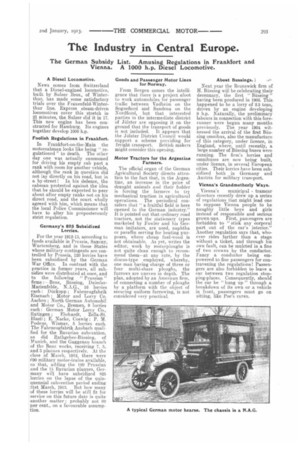The Industry in Central Europe.
Page 17

If you've noticed an error in this article please click here to report it so we can fix it.
The German Subsidy List. Amusing Regulations in Frankfort and Vienna. A 1000 h.p. Diesel Locomotive.
A Diesel Locomotive.
News comes from Switzerland that a Diesel-engined locomotive, built by Sulzer Bros., of Winterthur, has made some satisfactory trials over the Frauenfeld-Winterthur line. Express steam-driven locomotives cover this stretch in 21 minutes, the Sulzer did it in 17. This new engine has been constructed for Hamburg. Its engines together develop 1000 h.p.
Foolish Regulations in Frankfort.
In Frankfort-on-the-Main the motorcabman looks like being " regulatioued " to death. The other day one was actually summoned for driving his empty cab past a rank with room for another vehicle, although the rank in question did not lay directly on his road, but in a by-street ! In his defence, the cabman protested against the idea that he should be expected to peer about after empty ranks not on his direct road, and the court wholly agreed with him, which means that the local Police Commissioner will have to alter his preposterously strict regulation.
Germany's 825 Subsidized Lorries.
For the year 1912-13, according to funds available in Prussia, Saxony, Wurtemberg, and in those States whose military contingents are controlled by Prussia, 120 lorries have been subsidized by the German War Office. In contrast with the practice in former years, all subsidies were distributed at once: and to the following " Prussian " firms :--Benz, Bussing, DaimlerMarienfelde, N.A.G., 16 lorries each : Diirkopp ; Fahrzeugfabrik Eisenach; Motor and Lorry Co. Aachen ; North German Automobil and Motor Co., Bremen, 9 lorries each: German Motor Loriy Co., Ratingen ; Ehrhardt, Zella-St. 131a,sii ; E. Nacke, Coswig ; P. M. Podeus, Wismar, 5 lorries each. The Fahrzeugfabrik Ansbach qualified for the Bavarian subvention, as did Rathgeber-Bussing, of Munich. and the Gaggenau branch of the 'Benz works, receiving 7, 5, and 3 placrues respectively. At the close of March, 1912. there were (190 military motor-trains available, so that, adding the 120 Prussian and the 15 Bavarian plaques, Germany will have subsidized 825 lorries on the lapse of the quinquennial subvention period ending 31st March, 1913. But how many of these lorries will be. still fit for service on this future date is quite another matter: probably not (10 per cent., on a favourable assumption. Goods and Passenger Motor Lines for Norway.
From Bergen comes the intelligence that there is a project afoot to work automobiles for passenger traffic between Vadheirn on the Sognefiord and Sandena on the Nordficird, but that inteiested parties in the intermediate district of Mister are opposing it on the around that the transport of goods is not included. It appears that the Jolster District Council would support, a scheme providing for freight transport. British makers might consider this opening.
Motor Tractors or the Argentine Farmers.
The official organ of the German Agricultural Society directs attention to the fact that, in the .Argentine, an increase in the price of draught animals and their fodder is forcing the farmers to try mechanical traction in agricultural operations. The periodical considers that " a fruitful field is here opened to the German industry." It is pointed out that ordinary road tractors, not the stationary types marketed by Fowler and his German imitators, are used, naphtha or paraffin serving for heating purposes, where cheap fuel-wood is not obtainable. As yet, writes the editor, work by motorploughs is not quite clean enough to recommend them—at any rate, by the discus-type employed, whereby, one man having charge of three or four multi-share ploughs, the furrows are uneven in depth. The plan, adopted by an American firm, of connecting a number of ploughs by a platform with the object of securing uniform furrowing, is not considered very practical. About Bussings. 1 Next year the Brunswick firm of H. Bussing will be celebrating their decennary, the first " Bussing" having been produced in 1903. This. happened to be a lorry of 2.5 tons,. driven by an engine developing 9 h.p. Naturally, the preliminary labours in connection with this forerunner were begun many months previously. The year 1904 witnessed the arrival of the first Bussing omnibus, also the manufacture of this category, under licence, in England, where, until recently, a large number of Bussing buses were running. The firm's lorries and: omnibuses are now being built, under licence, in several Europeancities. Their lorries have been subsidized both in Germany and Austria for military transport.
Vienna's Grandmotherly Ways.
Vien Ila s municipal tramcar directors recently drew up a series of regulations that might lead one to suppose Vienna people to be naughty little boys and girls instead of responsible and serious grown-ups. First, passengers areforbidden to "stick any corporal part out of the car's interior." Another regulation says that, whoever rides farther than a stage without a ticket, and through his own fault, can be mulcted in a fine of two crowns by the conductor. Fancy a conductor being empowered to fine passengers for contravening the regulations! Passengers are also forbidden to leave a, car between two regulation stopping-places. Consequently, should' the car be "hung up" through a breakdown of its own or a. vehicle in front, passengers must go on sitting, like Poe's raven.






















